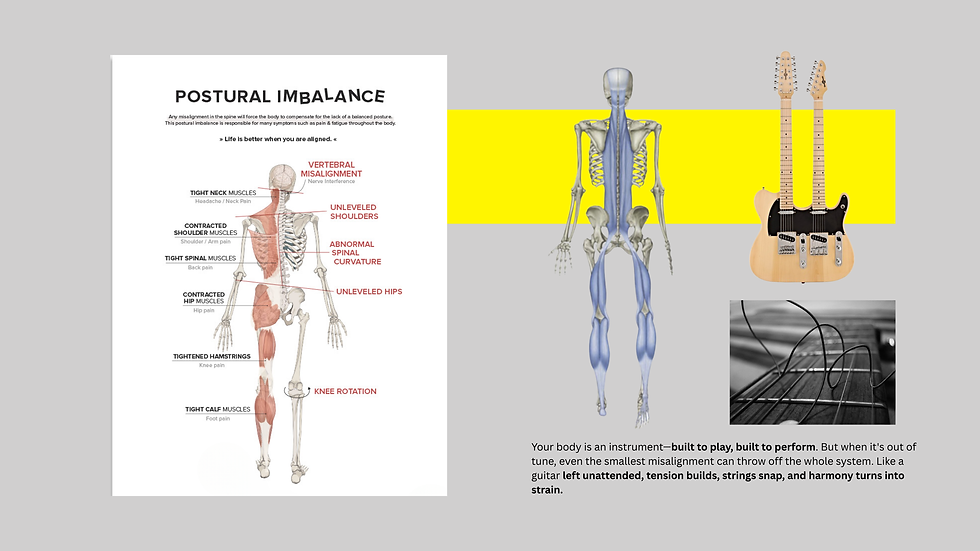Tuning Your Body Like an Instrument: Understanding Fascia and the Key to Movement Health
- John Gibson
- May 4
- 3 min read

When a musician tunes their instrument, they're not just prepping for a perfect performance—they're protecting the instrument itself. An untuned guitar or violin doesn’t just sound off; it creates strain that, over time, can cause damage. Your body operates the same way.
At the heart of this tuning process lies a powerful yet often overlooked structure in the human body: fascia. Let's explore how fascia acts like your body's internal strings, and why keeping them "in tune" is crucial for optimal health and performance.
What Is Fascia?
Fascia is a thin yet strong connective tissue that weaves throughout your entire body. It surrounds muscles, bones, organs, and nerves—creating an interconnected system that helps maintain structure, transmit force, and support movement.
Think of fascia as your body’s internal webbing or bodysuit. It not only holds everything in place but also allows different parts of the body to communicate and move as one unified structure.
Some fascial lines—called myofascial meridians—literally run from the crown of your head to the soles of your feet. These tissue tracks are similar to guitar strings stretched along the body. When in proper tension, they allow you to move freely, fluidly, and painlessly.
The Music of Movement: Fascia and Tensegrity
To understand how fascia affects movement, we need to borrow a concept from architecture called tensegrity, or tensional integrity. Your skeleton doesn’t hold itself upright alone—it's suspended within this fascial web, with bones floating inside a balanced tension system.
When everything is evenly tuned, tension is distributed throughout the system. You feel light, aligned, and strong.

But when fascia becomes restricted or imbalanced—due to injury, poor posture, stress, or repetitive movement—you get misalignment. This is like having one loose or overly tight string on your guitar.
Just like in music, the whole system begins to suffer:
Movement becomes inefficient or jerky
Pain or stiffness begins to appear
Mobility decreases
Compensations develop in other areas
Performance (whether walking or athletic) declines

Common Causes of “Mistuned” Fascia
Fascia adapts to how we use our bodies. That’s both a blessing and a curse.
Over time, if you sit too much, move in limited ways, or don’t stretch or hydrate enough, fascia can become adhesed, thickened, or dehydrated. This leads to poor “tuning,” much like letting an instrument sit in a hot, dusty attic.
Top causes of fascial dysfunction include:
Sedentary lifestyle
Repetitive or one-dimensional movement
Injury or trauma
Emotional stress (yes, fascia responds to emotional tension!)
Poor hydration
Keeping Your Fascia—and Body—In Tune
Just like an instrument needs regular tuning, your fascial system needs regular care. Here are some ways to keep your body harmonized and moving well:
1. Stretch with Intention
Instead of static stretching, focus on dynamic, myofascial techniques like those found in yoga, functional mobility flows, or fascial stretching.
2. Move Often and Move Differently
Your fascia loves variety! Walk, run, jump, crawl, hang, twist—add variety to your movement patterns to keep tissues elastic and responsive.
3. Hydrate Your Tissue
Fascia is made up of a gel-like substance that requires water to stay supple and slide freely. Drink plenty of water and avoid dehydration.
4. Use Self-Myofascial Release Tools
Foam rollers, massage balls, and fascial release tools can help break up adhesions and improve tissue quality.
5. Breathe and Relax
High stress = tight fascia. Deep, diaphragmatic breathing and mindful practices help relax your nervous system and soften tissue tension.
Your Body Is a Symphony – Keep It in Tune
Fascia is more than just connective tissue—it's your body's internal music. When tuned properly, you move with rhythm, flow, and balance. Neglect it, and you'll slowly fall out of sync, increasing the risk of dysfunction, pain, and poor performance.
So next time you stretch, hydrate, or roll out a tight spot, remember: you're not just loosening a muscle—you’re tuning an instrument.
Treat your body like the beautifully designed instrument it is—listen to it, care for it, and keep it in balance. The music of movement depends on it.




Comments